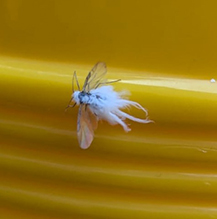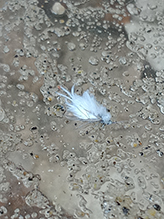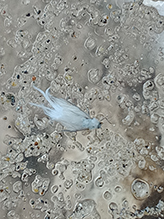woolly aphids and gall-making aphids
(subfamily Eriosomatinae)
Overview • Description • Distribution • Taxonomy
Description |
Eriosomatinae are soft-bodied, usually somewhat pear-shaped, and ⅛″ to 5⁄16″ (4 to 8 mm) in length. Most produce large amounts of a filamentous substance that appears woolly or waxy and covers all or nearly all of the body, both in the nymphal and adult stages. This is the feature that gives the subfamily the first of its two common names. However, this feature is not unique to this family. Nymphs feed in close aggregations, forming a large woolly mass for protection. Some Eriosomatinae have a pair of very small finger-like processes (cornicles) near the end of the abdomen. Others have no cornicles. When wings are present they are membranous and are not covered with a whitish powder. The media vein (M) on the forewing is not branched. The hindwing is much smaller than the forewing. The last part of the leg (tarsus), corresponding to the foot, has two segments. |
Distribution |
||
|
Sources |
|
| 8/18/2024 | ||
Taxonomy |
|
Order |
Hemiptera (True bugs, Hoppers, Aphids, and Allies) |
Suborder |
Sternorrhyncha (plant-parasitic hemipterans) |
Infraorder |
Aphidomorpha (aphids and allies) |
Superfamily |
Aphidoidea |
Family |
Aphididae (aphids) |
Until recently, the subfamily Eriosomatinae was placed in the family Eriosomatidae (=Pemphigidae). In 2008 it was transferred to the family Aphididae. The former family is no longer considered valid. |
|
Subordinate Taxa |
|
Tribe Eriosomatini Tribe Fordini Tribe Pemphigini |
|
Synonyms |
|
|
|
Common Names |
|
woolly aphids woolly aphids and gall-making aphids |
|
Glossary
Gall
An abnormal growth on a plant produced in response to an insect larva, mite, bacteria, or fungus.
Tarsus
On insects, the last two to five subdivisions of the leg, attached to the tibia; the foot. On spiders, the last segment of the leg. Plural: tarsi.
Visitor Photos |
||
Share your photo of this insect. |
||
This button not working for you? |
||
Mary |
||
 |
||
Mike S |
 |
landed on my drinking glass on the back deck. |
Desara G |
||
 |
 |
|
 |
 |
|
Greg Watson |
 |
When I first saw the Wooly Aphid, it was flying and kind of looked like a piece of dryer lint floating! |
MinnesotaSeasons.com Photos |
||
|
||
|
||

Slideshows |
|

Visitor Videos |
||
Share your video of this insect. |
||
This button not working for you? |
||
|
Other Videos |
||
The white garden fairy's are out to play today. |
About
Jun 18, 2015 I have no clue yet what these are. But they do look like mini fairy's. Some form of moth. Please let me know if you know what they are. Update: They are Eriosomatinae (Woolly aphids) Woolly aphids are sucking insects that live on plant fluids and produce a filamentous waxy white covering which resembles cotton or wool. The adults are winged and move to new locations where they lay egg masses. (Wikipedia) |
Woolly Aphid (Aphididae, Eriosomatinae) communal threat display |
About
Sep 30, 2013 When threatened (in this case by us flicking the branch they were feeding on), woolly aphid nymphs wave their abdomens and the waxy protuberances they produce back and forth. These aphids are feeding on American Beech (Fagus grandifolia), and are likely nymphs of Grylloprociphilus imbricator, the Beech Blight Aphid (http://bugguide.net/node/view/240499). Sorry Miley, but insects have been twerking for millions of years! More info on dancing woolly aphids by Becca Crew on her Scientific American Running Ponies - http://bit.ly/Rl936H License |
What are the white fuzzies flying around and the sticky stuff on your car? Woolly Aphid |
About
Sep 21, 2017 Amy Dismukes tackles the questions: what are the white fuzzies flying around and what's the sticky stuff on your car? |
Wooly Aphid Movie.avi |
About
Dec 3, 2009 Wooly aphids gettin' down |
Woolly Aphids |
About
Apr 25, 2017 AKA Zombie cotton |

Visitor Sightings |
||
Report a sighting of this insect. |
||
This button not working for you? |
||
PAULA RAJALA |
Location: 3621 HWY 38 GRAND RAPIDS, MN I caught a sample and put it under my "microscope" - it looks EXACTLY like this image from the website of the Montana Natural History Center: https://www.montananaturalist.org/blog-post/wooly-aphids/ It doesn't look at ALL like the other images of Woolly Aphids on your site or the UofM Extension page. We have lived on this property for 28 years and have never seen these. Are they new to this area? Should we be concerned? |
|
John Valo |
It's very common to suddenly notice woolly aphids, even if you haven't seen them before, as their populations can fluctuate year to year. Given their known distribution, it's highly likely these aphids, especially if they are the woolly alder aphid (Prociphilus tessellatus), are native to Minnesota and not new to the Grand Rapids area. While they can make plants look a bit messy with their white, waxy covering and sticky honeydew, they rarely cause significant harm to established trees. They are a natural part of the ecosystem and serve as a food source for many beneficial insects. Generally, there's no need for concern or intervention, as natural predators will often keep their numbers in balance. |
|
Dick Tamte |
Location: Iron Mn |
Mary |
Location: LeSueur and Rice County |
 |
Rachael |
Location: Belle Plaine, MN landed on my arm as I was sitting in my backyard! Looked like a tiny floating piece of cotton. |
|
Karissa |
Location: Shakopee MN |
Erin S. |
Location: Peace Township |
| Mike S 7/2/2024 |
Location: St. Peter, MN landed on my drinking glass on the back deck. |
Kgrudain |
Location: Bristol County, Massachusetts Flying around porch lights |
|
| Desara G 6/12/2023 |
Location: McDowell County NC |
 |
| Greg Watson 7/1/2021 |
Location: in my backyard in La Crescent, MN When I first saw the Wooly Aphid, it was flying and kind of looked like a piece of dryer lint floating! |
MinnesotaSeasons.com Sightings |
||
|

Created: 9/1/2021 Last Updated: © MinnesotaSeasons.com. All rights reserved. |



